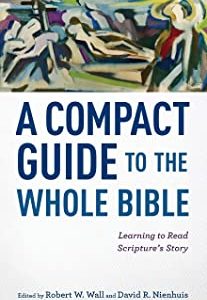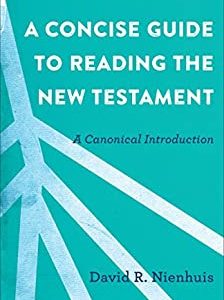So You Want to Read the Bible . . .
In my last post I wrote about the upsides of giving stuff up during Lent. Another possibility is to add something.
One possible add would be reading in the Bible. After our February 9 panel, “The Bible in a Post-Biblical Age,” I heard from several of you saying something like, “I’d like to read the Bible, but when I’ve tried I haven’t had much luck.”
 I get that. The Bible is not an easy book. It isn’t really designed for a straight through read, like a novel or a non-fiction book on one topic. When I run into folks who say they’ve “read the whole Bible straight through,” I always wonder how in the world they’ve managed that. Such ventures usually run aground at Leviticus (the third book of the Bible) — if you even make it that far.
I get that. The Bible is not an easy book. It isn’t really designed for a straight through read, like a novel or a non-fiction book on one topic. When I run into folks who say they’ve “read the whole Bible straight through,” I always wonder how in the world they’ve managed that. Such ventures usually run aground at Leviticus (the third book of the Bible) — if you even make it that far.
In the February 9 discussion, one of the panelists, Sara Koenig, spoke of the bible as a “library,” which is a helpful way to think of it. There are many kinds of literature here — history, poetry, letters, law codes, short stories, visions, epic sagas. Moreover, it was written over a 2,000 year time span, in a variety of different cultural contexts.
So if you don’t have a lot of luck just opening it at page one and ploughing ahead, don’t feel bad. Feel normal. I tend to think the only people who do read it straight through are those working on the, “I read the whole Bible” merit badge. And for bragging rights.
That said, it’s probably a good idea to ponder your own motivations before beginning a practice of bible reading. If you’re doing it because you think you “should,” as in “Gee, I’ve always felt I should read the Bible” or “I should know the Bible better,” chances are your “shoulds” won’t get you too far.
A better reason might be “curiosity.” “Gosh, I wonder what I’ll find?” A really good reason to read the Bible is to listen for God speaking through it. Take a passage, read it once, pause, read again slowly. Then ask, “What words or phrases” stand out or jump out at me? Mull those over. Ask yourself, why, for example the phrase “heart of stone” in Ezekiel 36 struck you? Or why the words, “all things are possible with God” in Luke 2 got your attention? Sometimes the words or phrases that delight or disturb us are the ones God is using to say something to us. Don’t worry too much about the “correct” understanding or interpretation. Just let it speak. If it seems “weird,” so much the better. Let it be weird. Weird is good.
One part of the Bible’s weirdness, for 21st century Americans, is that the Bible isn’t about you. It’s not a self-improvement book, or a book about how to make your life more meaningful (although that might happen as a secondary by-product) or successful. The Bible is about God. It is God’s story.
 Beyond that, where might one begin? Here are a couple options. Begin, as the New Testament does, with the Gospel of Matthew. Read a chapter a day, or less, half or a third of a chapter. Make notes about which words/ phrases strike you. Write down questions you have. Part of the reason that the Gospel of Matthew begins the New Testament is that it has a lot of Old Testament references, so it functions as a kind of transition from the Old to the New Testament.
Beyond that, where might one begin? Here are a couple options. Begin, as the New Testament does, with the Gospel of Matthew. Read a chapter a day, or less, half or a third of a chapter. Make notes about which words/ phrases strike you. Write down questions you have. Part of the reason that the Gospel of Matthew begins the New Testament is that it has a lot of Old Testament references, so it functions as a kind of transition from the Old to the New Testament.
Another option is to start by reading the Gospel of Mark. There are two reasons for that. One, of the four gospels, it is the shortest — just 13 chapters (Matthew is 28). So you’ll get a sense of accomplishment sooner, with less effort. And, if you are a church-goer, and if your church/ minister, uses the Common Ecumenical Lectionary, this is the year of the Gospel of Mark, so you’re hearing from Mark anyhow.
“Common Ecumenical Lectionary?” What’s that? A list of readings for each Sunday. Lectionaries have existed as long as the Bible has. The “Common Ecumenical Lectionary” is used all the time by many churches — Catholic, Lutheran, Episcopal. For others — Methodists, UCC, Presbyterian and many more — use of the lectionary is more optional but still common. A lectionary imposes some order on a church’s reading of the Bible and insures that you don’t hear only your preacher’s favorite parts.
If you get into it, read Matthew then Mark, or Mark then Matthew, and compare the two. Each of the four gospels presents a somewhat different “portrait” of Jesus. Compare and contrast. What do you notice?
Most Bible commentaries and reference books offer way too much information, and will overwhelm. But there a couple short background books that I would recommend, both from people who were on our February 9 panel. For the whole shebang, try A Compact Guide to the Whole Bible, edited by Rob Wall and Dave Nienhuis. For the New Testament, or as a follow up to A Compact Guide, read A Concise Guide to the New Testament by Dave Nienhuis. Both are fairly short. Both help you see the forest beyond the trees.
So, if you give this a whirl, set the bar low. Don’t worry too much about, “Am I interpreting this correctly?” or “Do I truly understand everything I’ve read?” Just read, with an open heart. See what words, phrases, stories speak to you. Trust that God can speak to you through this ancient, Irish stew of a book. If you don’t “hear” something immediately or during any one day’s reading, don’t fret. Sometimes things will pop up in your dreams or when on a walk or in conversation. Be open. Curious.
Final words . . . the Bible is really meant to be read in a community of faith, whether that’s 2 or 3, or way more. It helps to hear what speaks to others, what thoughts or questions they have in response to what they read. So if you can read together with a couple others, or talk about what you’ve read, that’s a great way to go.
Last note, which translation? If you enjoy Shakespeare, try the King James Version. If you want a more contemporary sound, go with Eugene Peterson’s paraphrase, The Message. Or one of the current standards, the New Revised Standard Version or the New International Version. Don’t use one that is bound with gold edges and has been in the family for a century. Too intimidating. Use one in which you are comfortable underlining, hi-lighting or making marks in the margins. Make it your own.
And let me know how it goes.
![Anthony B. Robinson [logo]](https://www.anthonybrobinson.com/wp-content/themes/anthonybrobinson/images/logo.png)
![Anthony B. Robinson [logo]](https://www.anthonybrobinson.com/wp-content/themes/anthonybrobinson/images/logo-print.png)